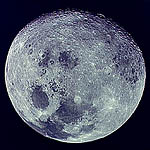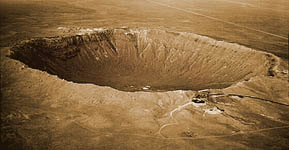 Exploring
Space, Page 5 of 6
Exploring
Space, Page 5 of 6
|
|

|
|
Earth's
moon is scarred by tens of thousands of craters, yet earth itself
has very few. Photo: NASA. [
Click
for a larger
image.]
|
![]()
Scientists theorize that collisions of astral bodies created the planets in our solar system. After the sun formed, bits of space dust collided to form specks, then rocks, then boulders. As the space objects got bigger, their gravitational pull attracted smaller ones. Eventually these "planetesimals" of rock, metal, and ice gobbled up most of the small meteoroids and became the familiar nine planets of our solar system. A swarm of asteroids, about 18,000, were left in a belt between Mars and Jupiter.
After the planets were formed, a process that may have taken almost 100 million years, asteroids continued to pelt the earth, with a violent collision occurring as often as once a month. Over time, the gravitational pull of the earth and moon swept up most of the stray asteroids in our part of the solar system; the impact rate today is therefore much less than it has been in the past.

|
|
|
Meteor Crater near Winslow, Arizona, was the first impact crater to be recognized as such. In 1957, a young graduate student named Eugene Shoemaker (later of Comet Shoemaker-Levy fame) convinced scientists that the iron fragments, a layer of broken rocks, and melted globs of soil were caused by a meteorite, not a volcano. Photo courtesy of John S. Shelton. [ Click for a larger image.]
|
Anyone with a decent
pair of binoculars can see the violent history of our solar system. The
near side of the moon is covered with more than 30,000 craters, yet they're
conspicuously rare on the earth's surface. In fact, only about 150 craters
have been found scattered around the world. Weathering and the movement
of the earth's crust have covered up or destroyed the earth's bombardment
record. One impressive exception is Meteor Crater in Arizona, a bowl-shaped
depression nearly a mile in diameter.
|
|
|
|